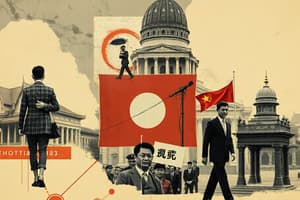Podcast
Questions and Answers
Why do critics say ASEAN adopted its charter in 2007 as 'old wine in a new bottle'?
Why do critics say ASEAN adopted its charter in 2007 as 'old wine in a new bottle'?
Most of the policies that lie within the charter are the same as the ones already existing in the ASEAN Way.
When was ASEAN created and what was the declaration that established it?
When was ASEAN created and what was the declaration that established it?
ASEAN was created on 8 August 1967 by the Bangkok declaration.
Why was ASEAN created?
Why was ASEAN created?
ASEAN was created due to the fear of communist expansion in the Southeast Asian region and to promote economic and cultural cooperation.
What were the reasons for ASEAN shifting its strategic policy post Cold War?
What were the reasons for ASEAN shifting its strategic policy post Cold War?
What were the common purposes of ASEAN's creation?
What were the common purposes of ASEAN's creation?
Which strategic policies did ASEAN adopt for dealing with Communism?
Which strategic policies did ASEAN adopt for dealing with Communism?
ASEAN is considered a supranational organization.
ASEAN is considered a supranational organization.
Explain why critics view ASEAN as a loose organization but it has survived for more than 50 years.
Explain why critics view ASEAN as a loose organization but it has survived for more than 50 years.
What factors drive regionalism in Southeast Asia?
What factors drive regionalism in Southeast Asia?
Why did ASEAN adopt a policy of regional integration post-Cold War?
Why did ASEAN adopt a policy of regional integration post-Cold War?
Flashcards are hidden until you start studying
Study Notes
Chapter 1: What and Why SEA?
- ASEAN was created on 8 August 1967, by the Bangkok declaration, due to:
- Fear of communist expansion in the Southeast Asian region
- Promotion of economic and cultural cooperation
- Post-cold war, ASEAN shifted its strategic policy because:
- ASEAN was no longer concerned about communism spreading in the region
- Focusing on economic development instead
- China's rise as a concern
- ASEAN wanted to focus on regional integration to expand the organization
- Belief that they must play a centrality role in order to promote relations and balance external powers
ASEAN's Geographical, Linguistic, Ethnic, Religious, Political, and Economic Diversities
- ASEAN consists of 10 members with diverse geographical landscapes, linguistic, ethnic, religious, political, and economic diversities
- 5 continental states: Cambodia, Thailand, Myanmar, Vietnam, Laos
- 5 maritime states: The Philippines, Malaysia, Indonesia, Singapore, Brunei
- Multiple ethnic groups in each state
- Religious diversity: Theravada Buddhism, Islam, Confucianism, Indic, Christian, etc.
- Political diversity: Absolutist monarchy, constitutional monarchy, republics, socialists
- Economic diversity: Low, low middle, upper middle, high income
SEA as an Interest Area
- Security interest:
- ASEAN located in southeast Asia and Asia Pacific region
- During the cold war, proxy interstate conflicts
- Post-cold war, proxy interstate conflicts decreased, regional power disputes increased (e.g., South China Sea, East China Sea)
- Economic interest:
- During the cold war, ASEAN became a newly industrialized export-led growth economy
- Post-cold war, ASEAN became a geo-economic importance
- Rich energy resources in Myanmar and Laos
- Regional mechanisms: AEC, AFTA, ASEAN+3, EAS, APEC, RBI, TPP, etc.
- Political interest:
- During the cold war, all ASEAN members were authoritarian regimes
- Western liberal democracy existed only post-cold war due to the collapse of socialism
- Efforts to apply democracy and standard of civil rights are still a contentious issue for ASEAN's geopolitical agenda
Chapter 2: Cold War in SEA
- The Cold War was a period of geopolitical tension between the Soviet Union and the United States and their respective allies
- Ideological struggle between capitalism and communism
- Proxy wars, espionage, and the threat of nuclear war
- SEA states concerned about communism due to:
- The Domino Theory
- Internal communist movements
- Memories of brutal communist regimes
Creation of ASEAN
- Common purposes:
- Promote regional peace and stability
- Foster economic cooperation among member states
- Address regional security threats, including communism
- Individual interests:
- Economic benefits: Increased trade and investment
- Security cooperation: Countering communist insurgencies
- Enhanced regional influence
ASEAN's Strategic Policies
- Five Power Defence Arrangements (FPDA): A loose agreement for military cooperation among Britain, Australia, New Zealand, Malaysia, and Singapore
- Treaty of Amity and Cooperation in Southeast Asia (TAC): Established principles for peaceful relations among member states
- Zone of Peace, Freedom and Neutrality (ZOPFAN): ASEAN adopted a zone of peace, freedom, and neutrality to show communist in Indochina that ASEAN was a peace-loving and neutral organization
- Bali Concord: Endorsed a collective political security
Studying That Suits You
Use AI to generate personalized quizzes and flashcards to suit your learning preferences.




